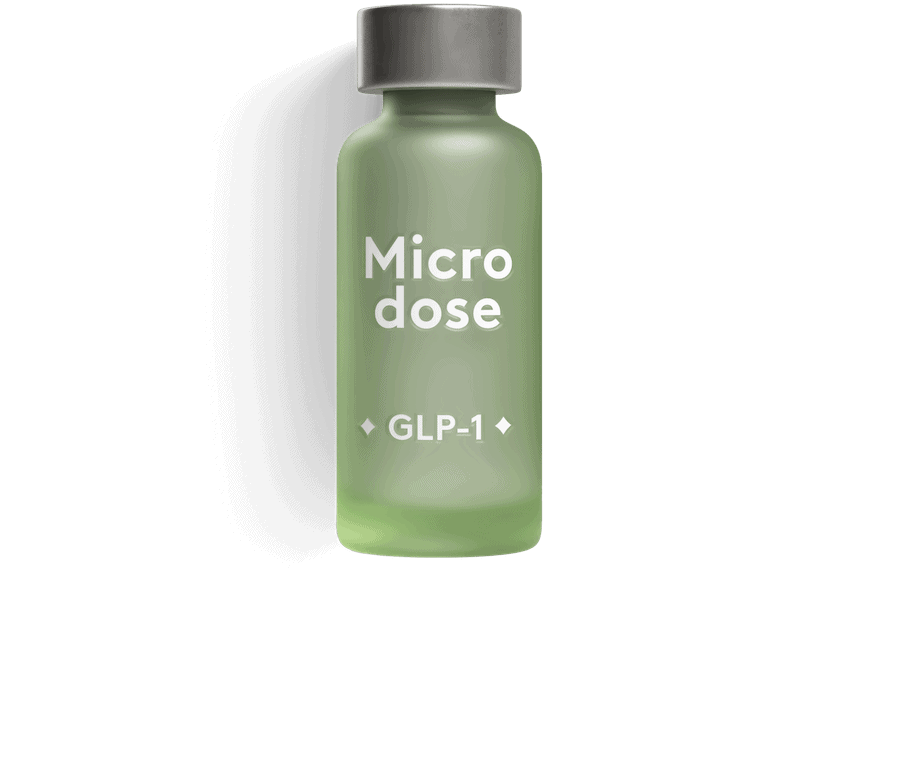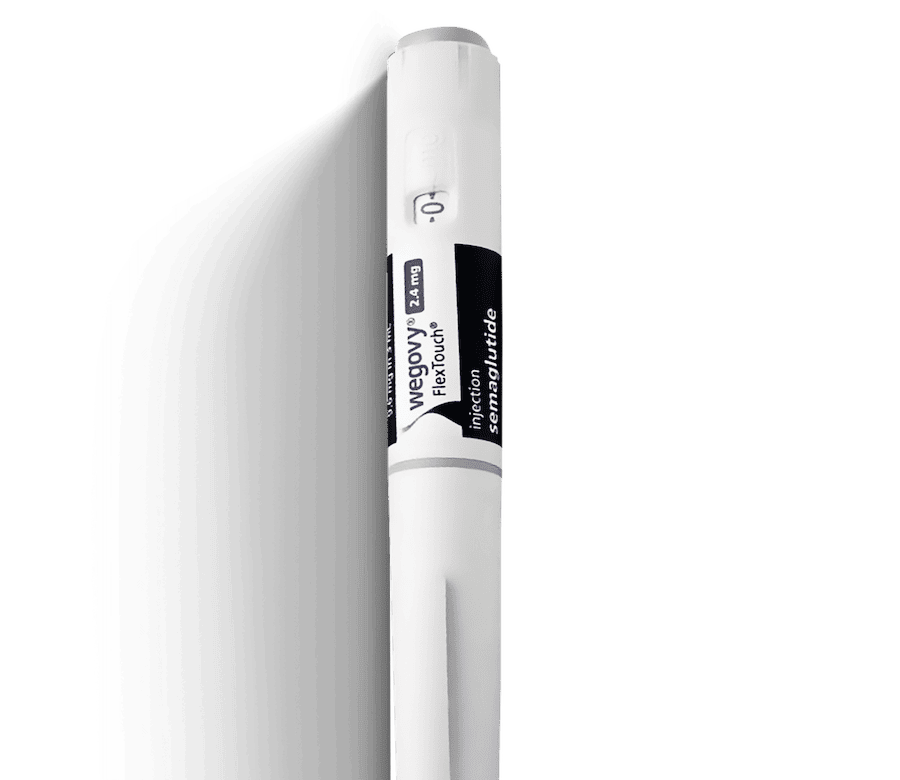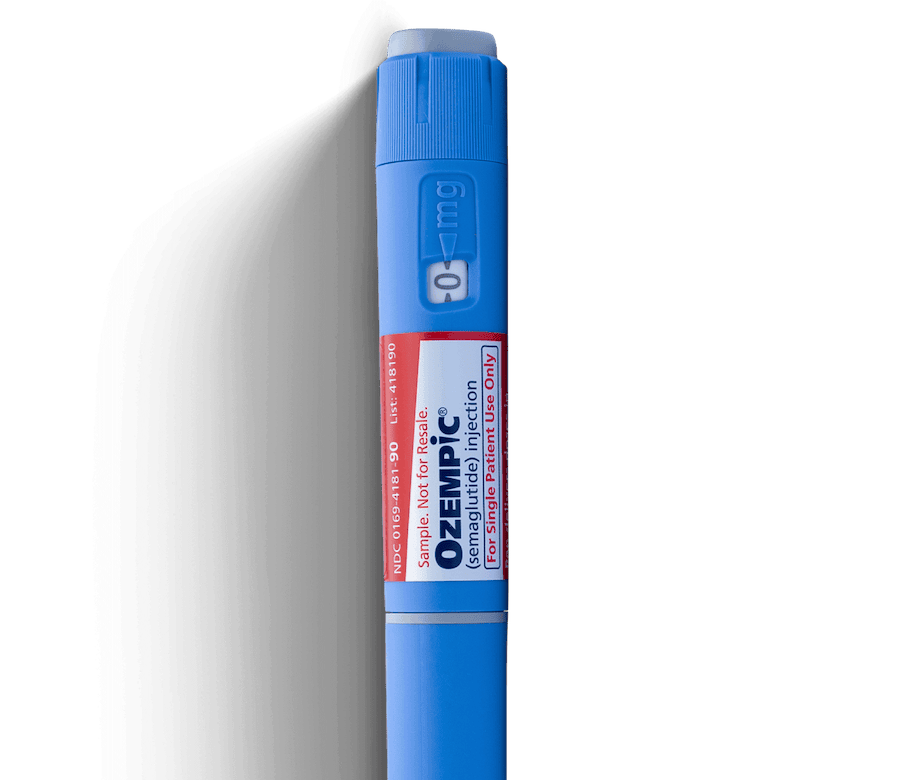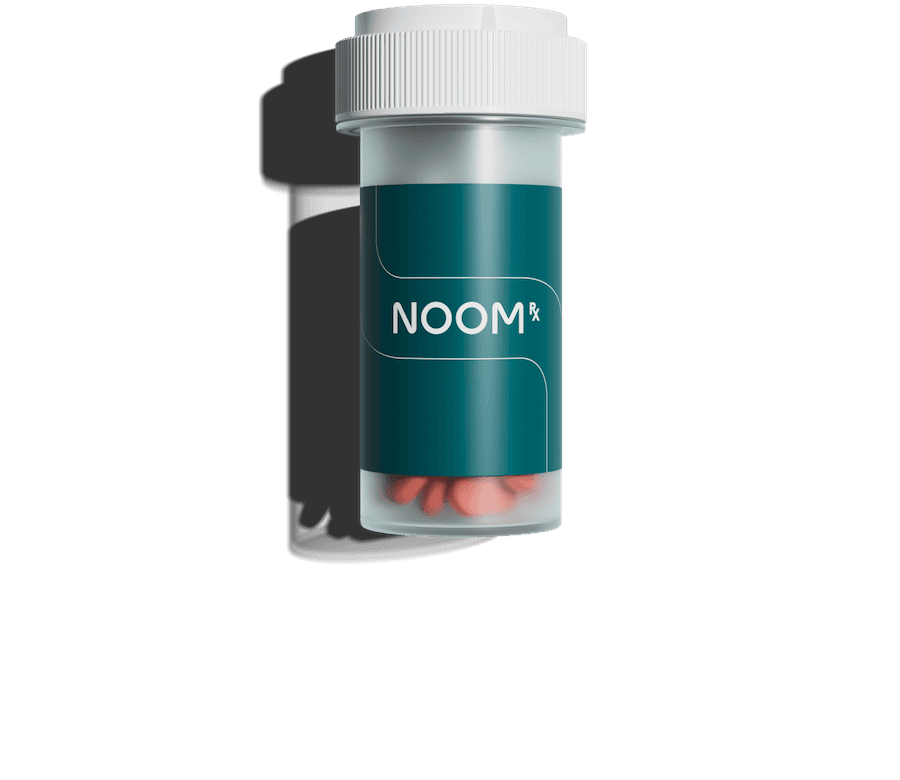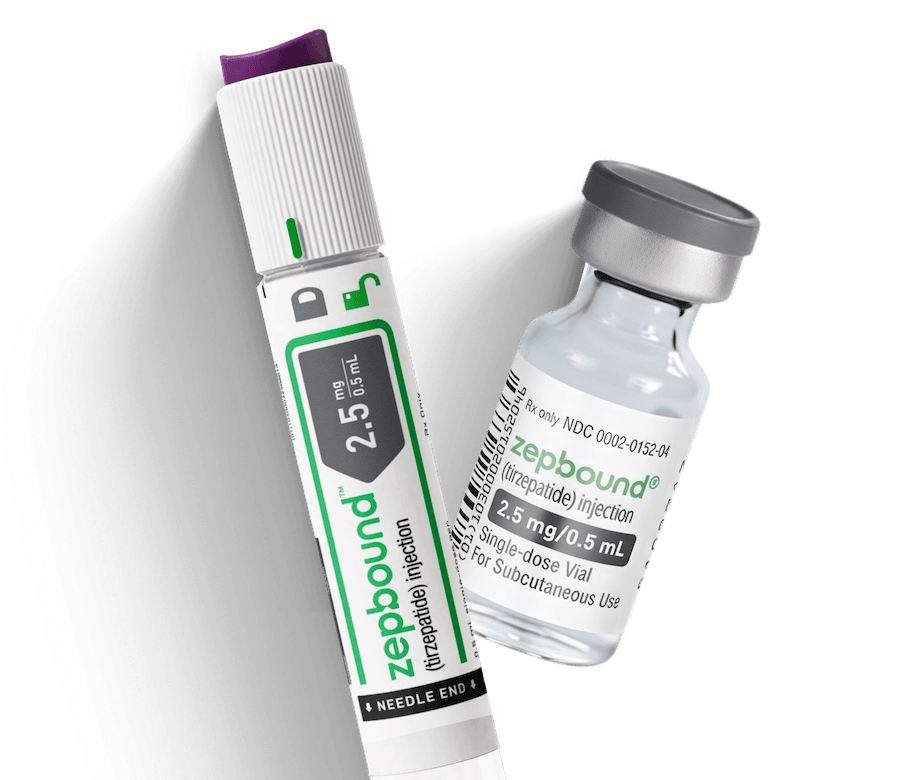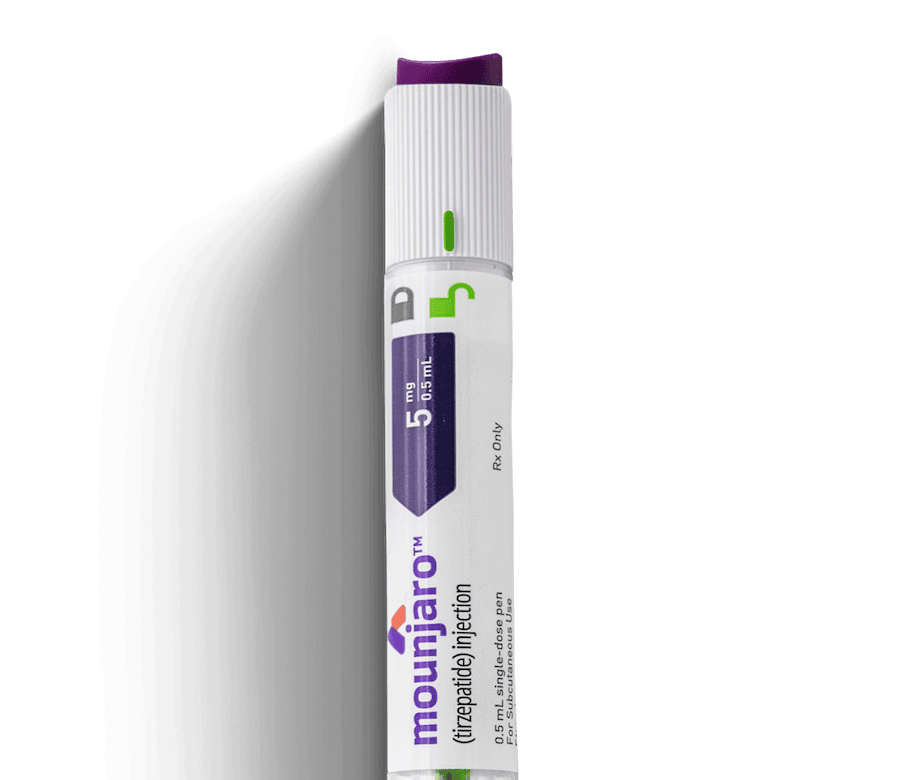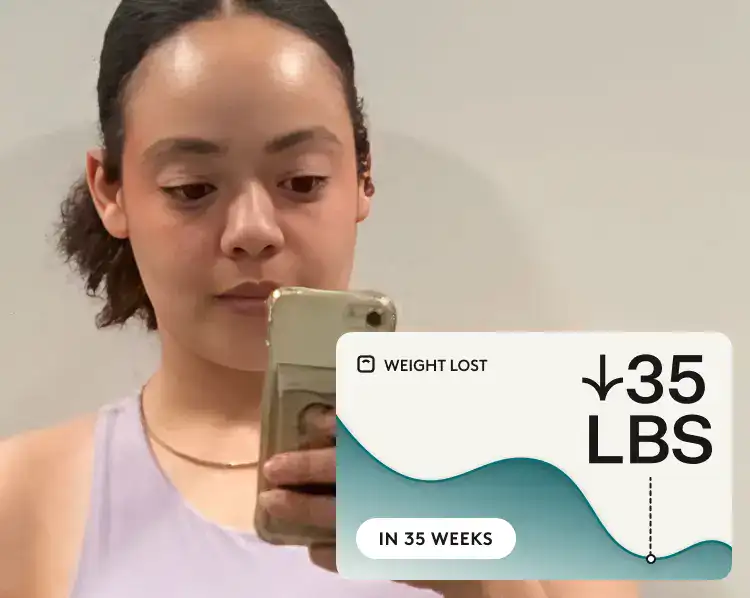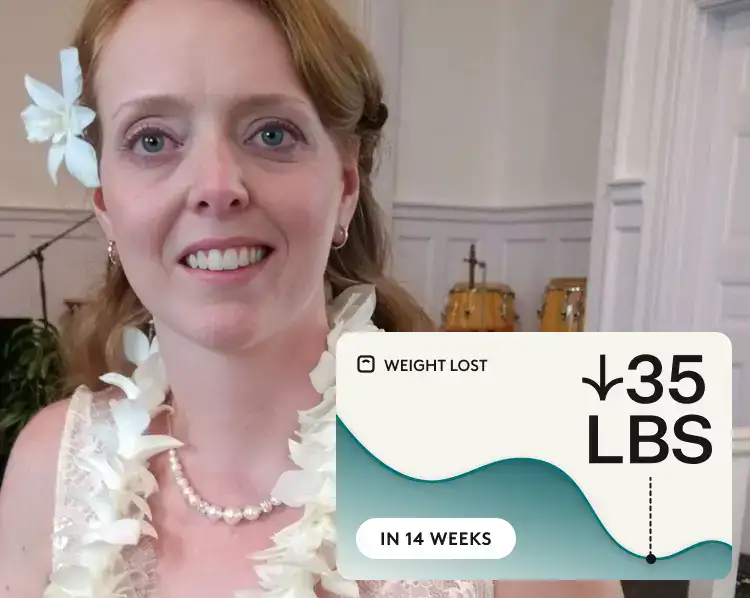What you’ll learn:
- Zepbound® and Contrave® are both FDA-approved for weight loss but differ in how they work.
- Zepbound® is an injectable medication that mimics two hormones, GLP-1 and GIP, to lower appetite and improve blood sugar control, while Contrave® is a pill that combines two medications to curb cravings and emotional eating.
- Zepbound® generally leads to greater average weight loss than Contrave® but comes with higher costs and requires injections.
In recent years, prescription weight loss medications have evolved rapidly, fueled by the popularity of Ozempic®’s off-label use. GLP-1 medications like Zepbound® and Wegovy® are now FDA-approved for weight management, redefining how people think about wellness and weight loss.
These newer drugs, which target key hormone pathways, have transformed how doctors approach obesity treatment. Take Zepbound®, for example. Made with tirzepatide, it’s a once-weekly injection that helps lower appetite, stabilize blood sugar, and slow digestion. It’s considered one of the most effective GLP-1 medications available today—but it isn’t the only option.
Contrave®, a daily prescription pill that combines two medications—naltrexone and bupropion—is also FDA-approved for weight loss. It targets hunger and reward centers in the brain, helping people curb cravings, build healthier habits, and lose weight over time.
So how does Contrave® stack up to Zepbound®?
In this guide, we’ll break down everything you need to know, from how Contrave and Zepbound work to their average weight loss results, side effects, costs, and insurance coverage. By the end, you’ll have the facts you need to talk with your doctor about which option may be the best fit for you.
Contrave® vs. Zepbound®: How do they work?
Both Contrave® and Zepbound® share the same goal, weight loss, but work differently in the body. Understanding how they work can help you figure out which might be a better fit for your lifestyle and health goals.
Contrave®
Contrave® comes in pill form and is a combination of two drugs: naltrexone and bupropion. Together, they work in the brain to help dial down appetite and curb cravings. Here’s how the two medications work alone:
- Bupropion is typically used to treat depression. It boosts certain neurotransmitters that help reduce hunger.
- Naltrexone is often used to treat opioid and alcohol use disorders. It blocks the receptors that trigger the “reward” response after eating high-calorie foods.
By targeting both hunger and reward pathways, Contrave® can make it easier to eat more mindfully and limit portion sizes.
Learn more: Contrave®: How to find the right dose for weight loss
Zepbound®
Zepbound®, taken once a week as an injection, contains the active ingredient tirzepatide, which mimics the hormones GLP-1 and GIP. These are hormones naturally released by your gut after you eat and help regulate appetite, digestion, and blood sugar.
By mimicking these hormones, Zepbound helps lower appetite, slows digestion, and improve blood sugar control. It also enhances your body’s insulin response after meals and may help the body use fat more efficiently for energy.
Learn more: What is Zepbound®? Exploring the weight loss benefits, side effects, and cost
Contrave® vs. Zepbound®: What are the differences?
While Contrave and Zepbound have lots of differences between them, one of the biggest is that Contrave comes as a pill you take daily, and Zepbound is a self-administered weekly injection. They also differ in cost, effectiveness, and how long you might stay on them. Let’s take a closer look at these to find out if one might be right for you.
How they are taken
As we mentioned, one of the biggest differences is how you take them:
- Contrave® is a daily oral medication, taken twice a day with meals. The dose is typically increased gradually over the first month until you reach two tablets twice daily.
- Zepbound® is a once-weekly injection, given under the skin using a prefilled pen or single-dose vial. Everyone starts at the lowest dose of 2.5 mg weekly. Gradual dose increases will follow each month as tolerated, and to keep you losing steady weight up to 15 mg. Not everyone needs 15 mg to lose steady weight.
Treatment length
Both medications are meant for ongoing use, but the timelines differ.
- Contrave® can be taken long-term if it continues to be effective and well-tolerated. Providers typically check progress after 12 to 16 weeks to confirm at least 5% weight loss before renewing treatment.
- Zepbound® is designed for extended use, often six months or longer. Many people also stay on it long-term to prevent weight regain.
Cost and insurance coverage
Because most insurance plans don’t cover weight loss medications, price can make a big difference when choosing between options. Here’s what to expect:
- Contrave®: Averages $600 to $800 per month without insurance. If you qualify, you can get your prescription filled through the manufacturer’s CurAccess™ program, and you’ll pay significantly less.
- Zepbound®: The list price is $1,000 to $1,080 per month without insurance. Eli Lilly’s patient assistance options, such as LillyDirect®, can help people save.
We’ll go through ways to save in the cost section below.
Effectiveness
Both medications help you lose weight, but the amount of weight that people average with each is different. Of course, your result will vary depending on lifestyle changes and exercise level. Overall, research has shown that people tend to lose more weight while taking Zepbound®. We’ll go into the details below.
Side effects
While nausea and constipation are common with both medications, they each affect your body a little differently and can cause varying side effects. Here are a few of the common side effects experienced with Contrave® and Zepbound®:
- Contrave®: Common side effects include nausea, constipation, dry mouth, headache, and insomnia. These usually improve as your body adjusts.
- Zepbound®: Digestive effects such as nausea, diarrhea, constipation, and stomach pain are most common, particularly when the medication is first started and during dose increases.
Contrave® vs. Zepbound®: What are the similarities?
Contrave® and Zepbound® may work in very different ways—one targets the brain, the other the gut and the brain—but they overlap more than you might think. Both are designed to help regulate appetite, support long-term weight management, and make it easier to stick to healthy habits over time.
Both are FDA-approved for weight loss
Both medications are FDA-approved. Contrave® was approved by the FDA in 2014, while Zepbound® received approval more recently in 2023.
- Both medications are approved for those with a BMI of 30 or higher, or a BMI of 27 or higher if you also have at least one weight-related health condition, such as high blood pressure or high cholesterol.
- Zepbound® can be used to help manage obstructive sleep apnea (OSA).
Both influence appetite and food cues
Even though they act in different ways, both help your body change how it responds to food.
- Contrave® works in the brain, dialing down hunger and reducing emotional eating by targeting the reward pathways that make food feel comforting.
- Zepbound® mimics natural gut hormones (GLP-1 and GIP) that tell your brain you’re not hungry, and slow digestion tells your brain you are full and keeps you satisfied longer.
The result? With both medications, people often find they eat less without feeling deprived—they’re just more in tune with fullness and satisfaction.
Both take time and consistency
Neither medication works overnight; they both take a little time to kick in. Your Contrave® dose will increase gradually over a four-week schedule to reach its full dose, and Zepbound® doses similarly increase every few weeks with guidance from your provider until you reach your ideal dose.
In both cases, results appear steadily, not suddenly. The key is consistency: taking your medication on schedule, checking in with your provider, and staying committed to the process. It’s also important to maintain healthy eating and exercise habits while you’re taking Contrave® or Zepbound® to both improve your weight loss results and help you to keep the weight off after you stop taking the medications.
Rx weight loss, the right way, with Noom
Get access to prescription weight loss medication with Noom.Contrave® vs. Zepbound®: Which works better for weight loss?
When it comes to weight management, both Contrave® and Zepbound® can help, but Zepbound has been shown to be more effective in clinical trials.
- Contrave® (naltrexone/bupropion): Clinical trials show that people who took Contrave® typically lost about 5 to 8% of their starting weight over 56 weeks when combined with balanced eating and activity. Those who saw early success, losing at least 5% by week 16, often went on to average around 11 to 12% weight loss at one year.
- Zepbound® (tirzepatide): Zepbound® tends to produce higher average results overall. In one study, people taking 15 mg lost an average of nearly 21% of their body weight over 72 weeks. Lower doses, 5 mg and 10 mg, produced average reductions of 15 to 20%.
How long does it take to see results?
- Contrave®: Most people first notice appetite and craving changes during the early weeks. Visible weight loss often follows around weeks 12 to 16, once the full dose is reached. Providers usually check progress at that point, continuing treatment if at least 5% weight loss has been achieved, a marker linked to stronger long-term outcomes.
- Zepbound®: Zepbound® starts at a dose of 2.5 mg of tirzepatide weekly, with the dose increasing gradually every few weeks. This slow, steady approach helps your body adjust and limits digestive side effects. Many people notice some weight loss from the first month, with most seeing a change between months 3 and 6, with the largest reductions appearing after 9 to 12 months.
Who can be prescribed Contrave® or Zepbound® for weight loss?
Before starting Contrave® or Zepbound®, your healthcare provider will look at your health history, current medications, and overall goals. Both medications come with specific eligibility requirements and safety considerations.
Who can take Contrave® for weight loss?
Contrave® is FDA-approved specifically for chronic weight management. It works best as part of a long-term plan that includes balanced nutrition, physical activity, and behavioral support.
You may qualify for Contrave® if you:
- Have a BMI of 30 or higher, or
- Have a BMI of 27 or higher with a condition such as high blood pressure or high cholesterol
Who shouldn’t take Contrave®?
Contrave® isn’t right for everyone. It may not be safe if you:
- Have uncontrolled high blood pressure.
- Have a current or past history of seizures.
- Are taking another medication that contains bupropion (such as Wellbutrin® or Zyban®).
- Have or have ever had an eating disorder, including anorexia nervosa or bulimia.
- Are dependent on opioids, currently taking medications to stop opioid use, or are in opioid withdrawal.
- Drink heavily and plan to stop alcohol suddenly.
- Stop using sedatives, benzodiazepines, or anti-seizure medications abruptly.
- Are taking a monoamine oxidase inhibitor (MAOI), such as linezolid or methylene blue, or have taken one within the last 14 days.
- Are allergic to naltrexone, bupropion, or any other ingredient in Contrave®.
- Are pregnant or breastfeeding.
For more details: Contrave® side effects: Symptom guide, & management tips
Who can take Zepbound® for weight loss?
Zepbound® is FDA-approved for weight management and is intended for long-term use alongside healthy lifestyle changes.
You may qualify for Zepbound® if you:
- Have a BMI of 30 or higher, or
- Have a BMI of 27 or higher with a related condition such as high blood pressure or high cholesterol.
Who shouldn’t take Zepbound®?
You can’t take Zepbound® if you:
- Have a personal or family history of medullary thyroid cancer (MTC) or multiple endocrine neoplasia syndrome type 2 (MEN 2)
- Are pregnant, planning to become pregnant, or breastfeeding
Talk to your doctor about whether Zebound is right for you if you:
- Have had severe gastrointestinal conditions, such as gastroparesis
- Have a history of pancreatitis or serious digestive issues
- Have kidney or liver problems that could affect how your body processes medication
Your healthcare provider may also review your medication list closely—Zepbound® can interact with certain diabetes treatments or insulin, which may increase the risk of low blood sugar.
For a full list of warnings and safety information, visit the Zepbound® safety page.
Can you switch between or combine Contrave® and Zepbound®?
Contrave® and Zepbound® both help with weight management, but they target separate systems, and any switch or overlap should only happen with your provider’s guidance.
If you’re switching between the two, here’s what usually factors in:
- Goals: Contrave® tends to support steady weight loss of an average of 5 to 8%, while Zepbound® often leads to larger reductions of 15–20% or more.
- Routine: Contrave® is a twice-daily pill; Zepbound® is a once-weekly injection.
- Side effects: Contrave® can cause headaches or sleep changes, while Zepbound® may bring short-term nausea or constipation.
- Cost: Contrave® averages $600–$800 a month (or $99 with CurAccess™), while Zepbound® ranges from $1,000 to $1,050 but may drop to $499 with savings programs.
If you’re moving from Contrave® to Zepbound®, Contrave® should be tapered first before starting Zepbound® to avoid withdrawal from bupropion. The reverse switch—from Zepbound® to Contrave®—means adjusting back to a daily schedule and potentially slower results.
Combining is sometimes done, but it’s off-label and should only be done with good reasons and under supervision. It’s not well studie,d but there are potential added benefits because the medications work on different pathways
If you take Contrave® or Zepbound® for weight loss, will you need to keep taking them forever?
That depends on your goals, your progress, and how your body responds. Both Contrave® and Zepbound® are designed for ongoing weight management, but the long-term plan looks a little different for each.
- Contrave® is often used long-term, but your provider will check your progress after about 12 to 16 weeks. If you haven’t lost at least 5% of your starting weight, it may be time to reassess. For those who benefit, it can be continued safely, but stopping suddenly isn’t advised. Your provider will usually taper the dose to avoid withdrawal effects.
- Zepbound® is approved for long-term weight management, and many people stay on it as long as it helps and side effects stay manageable. If you stop, appetite and weight can return quickly, so tapering slowly and maintaining your healthy habits is key.
Contrave® vs. Zepbound®: Costs and insurance considerations
Cost plays a major role when deciding between Contrave® and Zepbound®. The actual amount you’ll pay depends on your insurance coverage, eligibility for savings programs, and where you fill your prescription. Keep in mind, though, that weight loss medications aren’t typically covered by insurance.
Contrave®
The list price for Contrave® usually ranges from $500 to $700 per month, but the manufacturer’s CurAccess™ program can bring the cost down to $99 per month with free shipping for eligible people.
- Private insurance: Many commercial plans don’t routinely cover Contrave® for weight loss. If they do, copays can range widely, from $50 to over $200 per month, depending on the plan and state.
- Medicare: Coverage for Contrave® under Part D or Medicare Advantage plans is limited. Weight-loss medications are generally excluded. When covered, costs can vary from $50 to $150 per month, depending on formulary placement.
- Medicaid: Coverage depends on the state. Some Medicaid programs classify Contrave® as a weight-management drug that requires prior authorization, while others exclude it completely. Copays, where applicable, usually range from $0 to $8 per month.
- VA and TRICARE: Contrave® is typically not covered by the VA or TRICARE for weight loss. Beneficiaries may still access it as a cash-pay prescription, but manufacturer savings programs cannot be applied through these plans.
Manufacturer savings
- CurAccess™ Program: Offers Contrave® for $99 per month with free home delivery to most U.S. states. Eligibility is open to both insured and uninsured people, though government beneficiaries (Medicare, Medicaid, TRICARE) must pay cash.
- Patient assistance programs: Available for people who meet specific income-based criteria, which can help offset or eliminate costs entirely.
Zepbound®
Zepbound® is among the higher-priced options in prescription weight management. The list price averages $1,086 per month for prefilled pens, though LillyDirect’s single-dose vials can bring out-of-pocket costs down to $349 for the 2.5 mg dose or $499 for higher doses.
- Private insurance: Many commercial plans won’t cover Zepbound® for weight loss. Some plans will cover it if prescribed for obstructive sleep apnea (OSA). Copays range widely, from $25 (with a savings card) up to $300 per month without one.
- Medicare: Traditional Medicare does not cover medications prescribed solely for weight management, but some Part D and Medicare Advantage plans have started to cover Zepbound® for its new OSA indication. Out-of-pocket costs vary depending on the coverage phase but generally range from $10 to $150 per month.
- Medicaid: Coverage varies significantly by state. Some states, such as California (Medi-Cal), now cover Zepbound® without prior authorization for weight loss or OSA, while others may exclude it altogether. Copays typically fall between $0 and $5, depending on state policy.
- VA and TRICARE: The VA covers Zepbound® on a limited basis, usually for OSA treatment, but not for general weight management. TRICARE may cover Zepbound® for OSA when prescribed by a network provider, with copays based on supply length and pharmacy type.
Manufacturer savings
- Zepbound® Savings Card: For people with commercial insurance, this card can lower monthly costs to as little as $25, provided their insurance covers the medication. Government insurance participants are excluded.
- Lilly Patient Assistance Program (PAP): May supply free or discounted Zepbound® to people who meet income and eligibility criteria.
- LillyDirect: Offers Zepbound in a vial and syringe format for $349 to $499 per month, depending on the dose, for those paying out of pocket.
Contrave® vs. Zepbound®: Side effects and safety information
When it comes to side effects, knowing what to expect helps you prepare, manage symptoms early, and recognize when to reach out to your provider. Some effects fade as your body adjusts, while others may need closer attention if they persist or become uncomfortable. Both are also associated with some rare but severe reactions that you need to be aware of.
Common side effects
Most side effects are mild and tend to fade as your body adjusts to the medication. Here’s what people most often experience:
- With Contrave®: Because Contrave® targets the brain’s hunger and reward centers, it can cause nausea, headache, constipation, dizziness, dry mouth, and trouble sleeping, especially when first starting or increasing the dose. Some people also notice mood changes or restlessness.
- With Zepbound®: Zepbound® often causes digestive-related side effects since it slows how fast food moves through your stomach. The most common are nausea, diarrhea, vomiting, stomach pain, or constipation.
Learn more about how to manage these side effects:
Contrave® side effects: Symptom guide & management tips
Zepbound® side effects: Symptom guide & management tips
Rare side effects and warnings
While most people tolerate both medications well, there are specific safety concerns to keep in mind.
Contrave®: Rare but serious side effects
Because Contrave® contains bupropion and naltrexone, it carries a few unique warnings for conditions that are medical emergencies.
- Seizures: There’s a small risk of seizures, especially if you take higher doses, have certain medical conditions, or use medications that interact with Contrave®. Never start or stop other prescriptions while taking it without your provider’s approval.
- Opioid-related risks: Contrave® blocks opioid effects, so taking opioids, including pain medications or recreational drugs, while on it can lead to overdose or withdrawal. Avoid opioids for at least 7–10 days before starting Contrave®, and seek emergency help right away if you experience trouble breathing, confusion, or unusual drowsiness.
- Allergic reactions: Go to the ER if you notice rash, itching, swelling of the lips or tongue, chest tightness, or difficulty breathing.
- Increased blood pressure or heart rate: Your provider will monitor these regularly, especially if you have a history of hypertension or heart disease.
- Liver issues: Tell your healthcare provider if you develop stomach pain that lasts more than a few days, dark urine, yellowing of the eyes or skin, or fatigue—these can be signs of liver stress.
- Mood or mental health changes: Because Contrave® affects brain chemistry, it can sometimes trigger mood swings, anxiety, or—rarely—manic or depressive episodes. Report any sudden emotional changes to your provider right away.
- Vision problems (angle-closure glaucoma): Seek emergency care if you experience eye pain, blurred vision, or redness in or around the eyes.
- Low blood sugar (for people with type 2 diabetes): If you’re taking insulin or sulfonylureas, check your blood sugar regularly when starting Contrave®—your levels may drop more than usual.
Get more information about the severe side effects of Contrave.
Zepbound®: Rare but serious side effects
Zepbound®’s effects center on digestion and metabolism, so most warnings relate to those systems.
- Pancreatitis: Severe upper abdominal pain that radiates to the back, with or without vomiting, requires immediate medical care.
- Gallbladder problems: Watch for upper right abdominal pain, nausea, or yellowing of the skin or eyes, and get immediate medical attention for these symptoms.
- Low blood sugar (hypoglycemia): This is more likely if Zepbound is taken with diabetes medications; signs include dizziness, shaking, sweating, or confusion.
- Kidney issues: Dehydration from persistent nausea or diarrhea can strain kidney function. Seek care if you notice swelling, fatigue, or reduced urination.
- Allergic reaction: Sudden swelling of the face, tongue, or throat, or trouble breathing, needs immediate emergency care.
- Thyroid tumors or cancer warning: In animal studies, tirzepatide (the active ingredient) caused thyroid tumors, but the connection hasn’t been established in humans. Get immediate medical care for any throat swelling, lumps, or trouble breathing.
Get more information about the severe side effects of Zebound.
For complete details on possible side effects and safety information, refer to the official prescribing information for Contrave® and the safety info for Zepbound®.
How to take Contrave® and Zepbound®
Contrave® and Zepbound® both follow a “start low, go slow” approach to help your body adjust and minimize side effects, but how you take them couldn’t be more different. One comes as a pill, the other as a weekly injection. Here’s what that looks like in practice.
Contrave®: Dosage and instructions
Contrave® is taken by mouth and follows a gradual step-up schedule to help reduce nausea and other early side effects.
- Starting dose: Begin with one tablet each morning during week 1. Each tablet combines 8 mg of naltrexone and 90 mg of bupropion, the two ingredients that work together to help manage cravings.
- Dosing schedule: Add evening and morning doses each week until you reach the maintenance dose of two tablets twice daily by week 4.
- How to take it: Swallow tablets whole with water; do not crush or break them, as they are extended-release.
- With meals: Take Contrave® with food, but avoid high-fat meals, which can increase side effect risk.
- Monitoring: Regular check-ins are important. Providers usually review your progress after 12 weeks to ensure you’ve lost at least 5% of your starting weight before continuing treatment.
Learn more: Contrave® dosage guide: How to find the right dose for weight loss
Zepbound®: Dosage and instructions
Zepbound® is a once-weekly injection taken under the skin (subcutaneously) in your stomach, thigh, or upper arm.
- Starting dose: Begin with 2.5 mg once weekly for four weeks.
- Dose increases: Your dose usually increases every 4 weeks as needed and tolerated. Here’s what that might look like for someone who will reach the full 15 mg dose. You can stay at lower doses if you are losing steady weight and are comfortable with the side effects.
- 5 mg weekly for weeks 5–8
- 7.5 mg weekly for weeks 9–12
- 10 mg weekly for weeks 13–16
- 12.5 mg weekly for weeks 17–20
- 15 mg weekly as the maximum maintenance dose
- Timing: You can inject Zepbound® any time of day, with or without food, just try to stick to the same day each week.
- Injection tips: Rotate injection sites weekly to avoid irritation.
- Monitoring: Your provider will adjust your dose based on tolerance and progress.
Learn more: Zepbound® dosage guide: How to find the right dose for weight loss
Contrave® vs. Zepbound®: Which one is right for you?
Choosing between these two prescriptions comes down to your health goals, lifestyle, budget, and comfort level with daily pills versus weekly injections. Here’s a quick side-by-side look at what sets them apart:
| Category | Contrave® (naltrexone + bupropion) | Zepbound® (tirzepatide) |
|---|---|---|
| How it works | Targets brain pathways that control hunger and reward. Naltrexone helps reduce food cravings, while bupropion supports appetite control and boosts metabolism. | Mimics two gut hormones—GLP-1 and GIP—to decrease appetite, slow digestion, and increase feelings of fullness. |
| How you take it | Oral tablets taken twice a day with food. | Once-weekly self-injection under the skin (abdomen, thigh, or upper arm). |
| Weight loss | Studies show an average weight loss of 7 to 8% of starting weight after 56 weeks, though early responders may lose 10 to 12%. | Clinical trials show average losses of 15 to 21% of starting weight after 72 weeks, depending on the dose. |
| Insurance coverage | Rarely covered for weight loss. | Same. |
| Monthly cost without insurance | Retail: $500–$700 per month.CurAccess program: $99 per month. | Retail: $1,000 to $1,086 for prefilled pens.LillyDirect: Getting single-dose vials through Eli Lilly lowers the price to $349 for 2.5 mg and $499 for all higher doses. |
| Available as a generic | No — brand name only. | Same. |
Alternatives to Contrave® and Zepbound®
If Contrave® and Zepbound® aren’t the right fit, other prescription options are available, ranging from GLP-1 medications like Wegovy® and Saxenda® to non-GLP-1 choices such as Qsymia®, metformin, or orlistat.
Each works in different ways—some curb appetite, others alter how your body absorbs calories—and they vary in cost, effectiveness, and convenience. A healthcare provider can help determine which alternative best matches your goals, health profile, and lifestyle.
GLP-1 receptor agonists
Beyond Zepbound®, other GLP-1 medications help control appetite and blood sugar and support steady weight loss.
| Medication | Brand names and uses | Cost per month (without insurance) | Effectiveness | How it’s taken |
|---|---|---|---|---|
| Semaglutide – GLP-1 receptor agonist | Wegovy®: weight loss and heart disease | $1,350$499 (NovoCare Pharmacy)Learn more. | People lost an average of 15% of body weight in 68 weeks. | Weekly injection |
| Liraglutide – GLP-1 receptor agonist | Saxenda®: weight lossGeneric liraglutid: weight loss and heart disease | Saxenda®: $1,350Learn more.Generic liraglutide: $470 – $700 | People lost an average of 5-6% of body weight in one year. | Daily injection |
Other medications
Prescription options outside the GLP-1 family can also help with weight management, offering alternatives for different health goals or preferences.
| Medication | Brand names | Cost per month (without insurance) | Effectiveness | How it’s taken |
|---|---|---|---|---|
| Phentermine | Lomaira®, Adipex-P® | $27-$100 | About 80% of people with a BMI of 30 or more lost at least 5% of their body weight in 6 months. | Daily pill |
| Topiramate and phentermine | Qsymia® | Generic: $200 and $250 Brand name: $240-$300 | People lost an average of 7% to 10% of their body weight over a year. | Daily pill |
| Metformin (off-label weight loss) | Glucophage®, Fortamet®, Glumetza® | Generic: $4–$15Brand name: $100–$500+Learn more. | People lost an average of about 6% of their body weight over six months while taking metformin. | Pill taken up to two times daily |
| Diethylpropion | Tenuate®, Tenuate Dospan® | $40-$85 | People lost an average of 10% of their body weight in 6 months. | Pill taken one to three times daily |
| Orlistat | Xenical®, Alli® | $50-$800 | People in a study lost about 10% of their body weight after taking Orlistat for 1 year. | Pill taken three times daily with meals. |
The bottom line: Contrave® or Zepbound® are two modern weight loss medications
Finding the right medication is about choosing what fits your life. The best one for you ultimately depends on your goals, lifestyle, and comfort level.
- Zepbound® generally leads to greater weight loss on average, but it comes with a higher cost and requires weekly injections.
- Contrave® offers a more affordable, pill-based option that helps manage cravings and emotional eating, though results tend to be more gradual.
Both medications work best as part of a long-term plan with consistent use, healthy habits, and regular follow-ups with your provider to make sure your progress stays on track.
The real progress happens when medication meets consistency. Pairing treatment with mindful eating, regular movement, and support from your provider helps turn short-term effort into long-term success.
Want a plan that combines both? See if you qualify for Noom Med. If so, our clinicians can help you figure out which medication might be the better fit, prescribe it if needed, and guide you on pairing it with lifestyle habits. Plus, you’ll get access to all of Noom’s tools, recipes, and trackers to make weight loss stick for the long term.
Why you can trust us
At Noom, we’re committed to providing health information that’s grounded in reliable science and expert review. Our content is created with the support of qualified professionals and based on well-established research from trusted medical and scientific organizations. Learn more about the experts behind our content on our Health Expert Team page.



